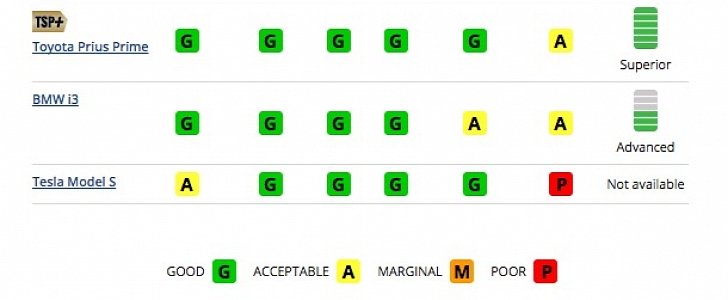Oh deary me, where do I begin? Both the Model S and i3 were refreshed for the 2017 model year with better styling or bigger batteries, respectively. Pretty good, right? Well, what Tesla Motors and BMW alike failed to do, however, is to impress the IIHS.
Let’s start with the EV to rule all electric vehicles. The 2017 Model S was rated “good” in the moderate overlap front, side, roof strength, head restraints, and seats test. In the small overlap front test, by contrast, the full-size sedan is “average” according to the Insurance Institute for Highway Safety. A “poor” rating was awarded for the headlight performance, whereas the ease of use of the child seat anchors can be described as “marginal.”
The IIHS discovered that the crash test dummy’s head hit the steering wheel through the airbag, which equates to injuries in a real-life situation. There's a problem with the seat belt, apparently, because it allowed the dummy to move too much forward. Injuries to the dummy’s right lower leg are also possible. The headlights, meanwhile, were rated “poor” by the Institute because low beams create glare and on curves, visibility is inadequate. Even when equipped with the curve-adapting function, the headlights don’t cut the mustard according to the Institute’s testing procedures for the 2017 MY.
As for the 2017 i3, the smallest electric model in BMW’s lineup earned “good” ratings in the following tests: small overlap and moderate overlap, side, and roof strength. Head restraints and seats are the main offenders according to the IIHS (“average”), as are the headlights and child seat anchors (“average”).
Neck injuries in a rear crash are possible in the i3, but on the upside, such injuries are rarely fatal. The thing is, neck injuries are the most common type of crash injury. When equipped with the halogen reflector-type high beams, visibility is inadequate on the left side of the road. On curves, visibility was deemed fair on both right curves and inadequate on both left curves.
It’s the little things that brought misfortune to the Model S and i3 in this round of IIHS tests. Neither EV was awared Top Safety Pick or TSP+.
The IIHS discovered that the crash test dummy’s head hit the steering wheel through the airbag, which equates to injuries in a real-life situation. There's a problem with the seat belt, apparently, because it allowed the dummy to move too much forward. Injuries to the dummy’s right lower leg are also possible. The headlights, meanwhile, were rated “poor” by the Institute because low beams create glare and on curves, visibility is inadequate. Even when equipped with the curve-adapting function, the headlights don’t cut the mustard according to the Institute’s testing procedures for the 2017 MY.
As for the 2017 i3, the smallest electric model in BMW’s lineup earned “good” ratings in the following tests: small overlap and moderate overlap, side, and roof strength. Head restraints and seats are the main offenders according to the IIHS (“average”), as are the headlights and child seat anchors (“average”).
Neck injuries in a rear crash are possible in the i3, but on the upside, such injuries are rarely fatal. The thing is, neck injuries are the most common type of crash injury. When equipped with the halogen reflector-type high beams, visibility is inadequate on the left side of the road. On curves, visibility was deemed fair on both right curves and inadequate on both left curves.
It’s the little things that brought misfortune to the Model S and i3 in this round of IIHS tests. Neither EV was awared Top Safety Pick or TSP+.




































